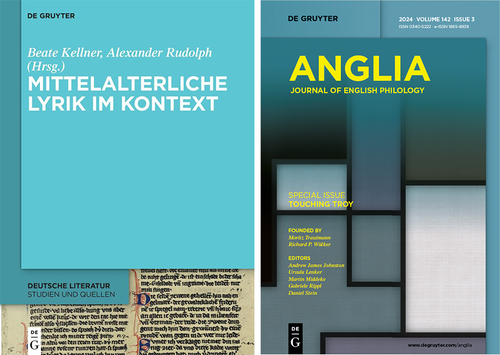Publication | Medieval Literature in Focus: The Birth of Old English Lyric Poetry (Johnston) and Touch within the Transmission of the Troy Story (Johnston et al., Eds.)
News from Feb 13, 2025
Drawing on the example of "Widsith", one of the few Old English elegies to combine striking formal complexity with sophisticated metapoetical reflections, Andrew James Johnston's essay "'Widsith' und die Geburt der altenglischen Lyrik aus dem Geist der Epik" (in German) demonstrates how early medieval English poetry developed and unfolded, by performative means, a specific understanding of the lyric. As argued by Johnston (Cluster Co-Director and member of Research Area 3: "Future Perfect"), the texts in question carved out a space for lyric poetry beyond the confines of the epic, thereby furnishing the underlying poetics with a formal and literary-historical foil and foundation while also allowing the distinct domain of the lyric to operate as a kind of laboratory in which literary-theoretical concepts could be put to the test.
Published in: Mittelalterliche Lyrik im Kontext, edited by Beate Kellner and Alexander Rudolph, 175–88. Deutsche Literatur. Studien und Quellen 49. Berlin/Boston: De Gruyter, 2024. (Open Access)
The Special Issue: Touching Troy (Anglia 142.3 [2024]), edited by Andrew James Johnston, Wolfram R. Keller (Research Area 3: "Future Perfect") and Henry Ravenhall, focuses on a narrative that enjoyed immense popularity in medieval and early modern Western Europe: the story of Troy. More specifically, the papers compiled in the volume address multiple questions associated with the problem of touch in medieval literature, and, in so doing, explore the relevance that issue may have for attitudes toward materiality in late modernity. Embracing a broad understanding of touch as a transformational epistemological category, as a way of knowing, of apprehending, of understanding entities, especially in material terms, but also as one of forming new relations, of producing new knowledge, of generating innovation and of expressing a desire for bridging the gap between the past and the present, the special issue thus takes a deliberately expansive view of the phenomenon to shed fresh light on the thick social and affective relations in which the Troy story came to be embedded across time.
